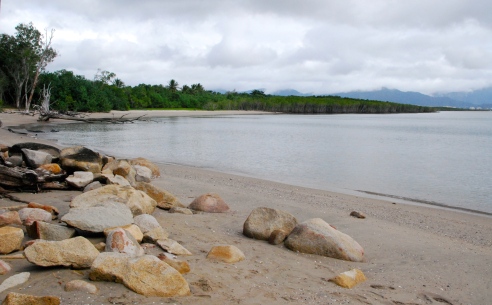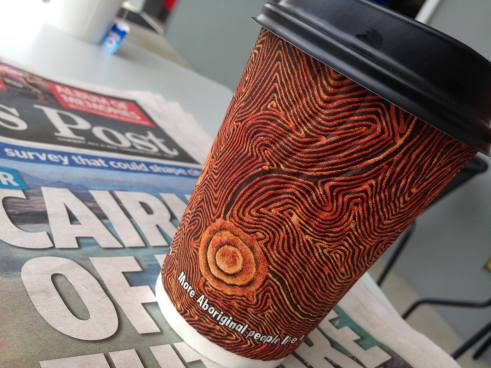Yarrabah – reality hits home in a place called ‘paradise by the sea’

As the crow flies, it’s only about 12km across Trinity Inlet from the bustling Far North Queensland tourist centre of Cairns to the Aboriginal community of Yarrabah.
By road, it’s about 60km – or 45 minutes drive – between the two. Once out of Cairns’ suburbs, the road loops through canefields, then hugs the coast. It’s a beautiful drive.
In Cairns on a travel writing assignment, but with a day free from “official” duties, I grab the offer to go to Yarrabah with my friend and colleague Christine, a Cairns-based journalist who specialises in writing for and about indigenous communities.
As we head along the eastern side of Trinity Inlet, the hotel towers of Cairns pop up in the distance above the cane; hard to believe it’s so close because for all the world, we could be in another country.
When we pull into a small beachside parking area at False Cape, I hop out of the car to take some photos. “Look out for crocs!” Christine warns, offering to be the lookout while I’ve got my eye to the camera. I keep a wary distance from the water, after that! And despite the cloudy skies, it’s a lovely peaceful scene, worth recording.


Up and over the Murray Prior Range, the road winds down into Yarrabah, which sits on the shores of Mission Bay, on the Cape Grafton Peninsula. These are the traditional lands of the Gunggandji people.
“Slow down a bit,” Christine warns, and I soon see why. Horses and dogs – lots of them – roam free here, and the roads belong to them as much as to anyone under motorised horsepower.
Our first stop in Yarrabah is the Gurriny Yealamucka Health Services Aboriginal Corporation (GYHSAC), where Christine has to deliver the latest print-run of the “Gurriny News” newsletter which she produces.
Next we head to the thriving Yarrabah Art Centre, where stock is on the low side as much of it is on its way to the Darwin Aboriginal Art Fair in a couple of weeks’ time. Next door, the Menmuny Museum is closed for repairs, so we’re out of luck today.


Then it’s time for a coffee, stopping at YarrieChino, one of several new businesses started by Yarrabah’s young women over the past year. I’m taken by the indigenous-styled paper cups for our coffee, which declare “More Aboriginal people live in western Sydney than anywhere else in Australia”.

And so begins a conversation which shocks me. “How many people live here in Yarrabah?” I ask.
Christine’s answer includes some information that puts another perspective on life in the simple weatherboard houses that make up the town. There are around 4000 people living in Yarrabah – but there are only 415 houses. Even my non-mathematical brain can do those sums, but I figure I must have it wrong. That’s about 10 people to a house.
“Uh-huh.” Christine’s grim smile confirms I’ve done the maths correctly.
“But it’s actually more because some of that housing stock is used for singles – teachers and health staff, people like that,” she adds.
Housing is a major issue for this community. Despite another eight houses being built recently, and the promise of another 20 over the next two years, overcrowding is a major problem and the new houses don’t even begin to take the pressure off the waiting list.
And as Australia heads for the next Census next month, the Yarrabah Aboriginal Shire Council is urging its residents to register. Funding for housing and other services depends on having an accurate count of how many people live here. It’s a far cry from the comfortable lives of city folk like me; in fact, like many Aboriginal communities Yarrabah has a history that is far from comfortable, and relatively unknown to most.
Before the 1850s, Aboriginal people living here had little contact with Europeans, but by 1892 an Anglican mission had been established at Yarrabah.
Over the years, government administrations forcibly relocated Aboriginal, Torres Strait Islander and South Sea Islander people to Yarrabah, according to the Yarrabah Aboriginal Shire Council’s official history of the town. In 1900, the mission was declared an “industrial school”, a place where “neglected” children were housed in dormitories after being taken from their parents under the Aboriginals Protection and Restriction of the Sale of Opium Act 1897. During this time, the Church also forced all residents – including children – to undertake unpaid farming work in order supply the mission with food. Sounds like slavery, to me.
Wandering in Yarrabah’s Old Cemetery, on the western side of the town, overlooking the beach, it’s hard to know how far back these graves date. A couple of frangipani trees stand as eerie sentinels, their bare branches almost matching the bleached look of the once-white crosses below them. About half the graves have crosses and concrete slabs, some with decorative concrete shells or hearts to mark them. Few bear names. The other half are marked out with stones. What stories lie beneath them?


The cemetery has recently undergone a clean-up, with locals working to pay tribute to those who’ve gone before. They’ve created a place of sad but immense beauty.

After years of difficulty, including a strike by the residents in 1957, by 1959 the Anglican Church had had enough and on 1 July 1960 the Queensland state government took over the mission. The first Aboriginal Council was established in the 1960s, and since 1986, the community has been self-governing under a Deed of Grant in Trust land tenure, subject to the Community Services (Aborigines) Act 1984. Because residents live in government housing, they do not pay rates to the council, which is funded by piecemeal grants and contracts, on top of a small core administrative lump sum.

The town has a health centre, library, pre-school, schools (to Year 10), a public swimming pool, small supermarket, aged care hostel, a couple of take-away shops, a hairdresser, a couple of banks and some government agencies.
For lunch, we stop for a burger at Gilpul Café, which was last year opened by 23-year-old Shennae Neal to provide work for five young local women. Yarrabah has 70 per cent youth unemployment, and the café is Shennae’s way of helping address that. And the burgers are great!
We sit soaking up the view of the beach, the rusting shipwreck off the coast and the sweep of Cape Grafton. It’s peaceful and beautiful, despite the rain clouds coming in.

‘Yarrabah’ was believed to be an Anglicised variation of a language name for the area where the mission was located. At the entrance to the township, there’s a sign welcoming visitors to Yarrabah – “Paradise by the Sea”.

Looking at the landscape, it’s easy to see why the shire council has chosen that up-beat slogan for the tourists they hope will come. But for some residents – especially those who wait for decent housing – it may not seem like paradise at all.
For me, getting off the tourist beat and into a community that has much to offer – given the chance – has revealed yet another layer of this country and its people.

4 Responses to “Yarrabah – reality hits home in a place called ‘paradise by the sea’”
Nice review. The frangipani trees and the old cemetery were planted by my grandmother. The first tree marks the grave of my uncle who died as an infant and the second marks the grave of my grandfather.
Thank you so much for your comment. The trees are so beautiful, I’m glad to know they were planted in memory of loved ones.
My mother and father were born in Yarrabah but moved to Cairns to make a better life for their family. We still had ties with Yarrabah and would spend time over there with our extended families. My parents are both buried together in the old Yarrabah cemetery.
I’m so glad that this story seems to have resonated with a lot of people who have links to Yarrabah. Thanks for sharing yours with me too.